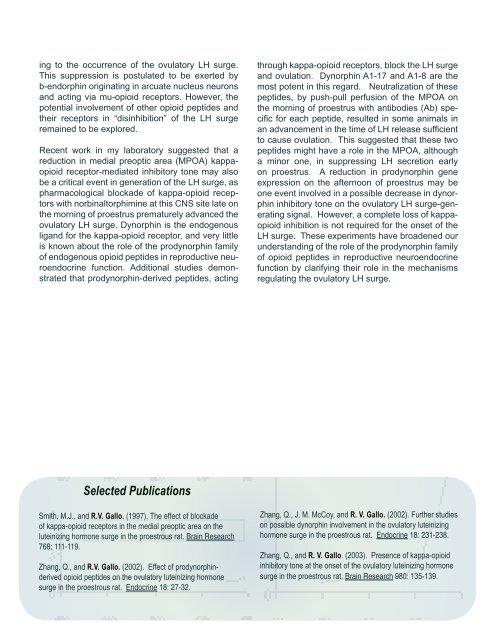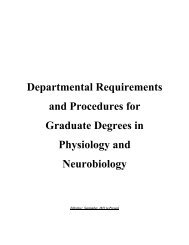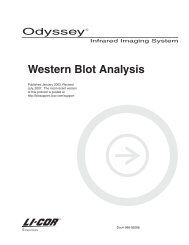Information Brochure (pdf) - Physiology and Neurobiology ...
Information Brochure (pdf) - Physiology and Neurobiology ...
Information Brochure (pdf) - Physiology and Neurobiology ...
You also want an ePaper? Increase the reach of your titles
YUMPU automatically turns print PDFs into web optimized ePapers that Google loves.
ing to the occurrence of the ovulatory LH surge.<br />
This suppression is postulated to be exerted by<br />
b-endorphin originating in arcuate nucleus neurons<br />
<strong>and</strong> acting via mu-opioid receptors. However, the<br />
potential involvement of other opioid peptides <strong>and</strong><br />
their receptors in “disinhibition” of the LH surge<br />
remained to be explored.<br />
Recent work in my laboratory suggested that a<br />
reduction in medial preoptic area (MPOA) kappaopioid<br />
receptor-mediated inhibitory tone may also<br />
be a critical event in generation of the LH surge, as<br />
pharmacological blockade of kappa-opioid receptors<br />
with norbinaltorphimine at this CNS site late on<br />
the morning of proestrus prematurely advanced the<br />
ovulatory LH surge. Dynorphin is the endogenous<br />
lig<strong>and</strong> for the kappa-opioid receptor, <strong>and</strong> very little<br />
is known about the role of the prodynorphin family<br />
of endogenous opioid peptides in reproductive neuroendocrine<br />
function. Additional studies demonstrated<br />
that prodynorphin-derived peptides, acting<br />
through kappa-opioid receptors, block the LH surge<br />
<strong>and</strong> ovulation. Dynorphin A1-17 <strong>and</strong> A1-8 are the<br />
most potent in this regard. Neutralization of these<br />
peptides, by push-pull perfusion of the MPOA on<br />
the morning of proestrus with antibodies (Ab) specific<br />
for each peptide, resulted in some animals in<br />
an advancement in the time of LH release sufficient<br />
to cause ovulation. This suggested that these two<br />
peptides might have a role in the MPOA, although<br />
a minor one, in suppressing LH secretion early<br />
on proestrus. A reduction in prodynorphin gene<br />
expression on the afternoon of proestrus may be<br />
one event involved in a possible decrease in dynorphin<br />
inhibitory tone on the ovulatory LH surge-generating<br />
signal. However, a complete loss of kappaopioid<br />
inhibition is not required for the onset of the<br />
LH surge. These experiments have broadened our<br />
underst<strong>and</strong>ing of the role of the prodynorphin family<br />
of opioid peptides in reproductive neuroendocrine<br />
function by clarifying their role in the mechanisms<br />
regulating the ovulatory LH surge.<br />
Selected Publications<br />
Smith, M.J., <strong>and</strong> R.V. Gallo. (1997). The effect of blockade<br />
of kappa-opioid receptors in the medial preoptic area on the<br />
luteinizing hormone surge in the proestrous rat. Brain Research<br />
768: 111-119.<br />
Zhang, Q., <strong>and</strong> R.V. Gallo. (2002). Effect of prodynorphinderived<br />
opioid peptides on the ovulatory luteinizing hormone<br />
surge in the proestrous rat. Endocrine 18: 27-32.<br />
Zhang, Q., J. M. McCoy, <strong>and</strong> R. V. Gallo. (2002). Further studies<br />
on possible dynorphin involvement in the ovulatory luteinizing<br />
hormone surge in the proestrous rat. Endocrine 18: 231-238.<br />
Zhang, Q., <strong>and</strong> R. V. Gallo. (2003). Presence of kappa-opioid<br />
inhibitory tone at the onset of the ovulatory luteinizing hormone<br />
surge in the proestrous rat. Brain Research 980: 135-139.





